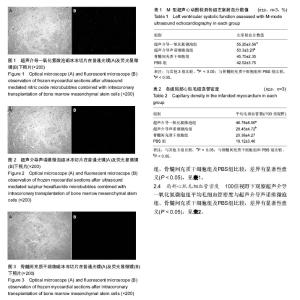| [1] Segers VF, Lee RT. Stem-cell therapy for cardiac disease. Nature. 2008;451(7181):937-942.[2] 童嘉毅,马根山,冯毅,等.超声波促骨髓间充质干细胞心肌内归巢的实验研究[J].中国心血管病研究, 2008,6(10):771-773. [3] 徐琢,冯毅,童嘉毅,等.超声微泡辅助干细胞移植治疗急性心肌梗死的实验研究[J].东南大学学报:医学版,2008,27(3):192-194. [4] Song X, Zhu H, Jin L, et al. Ultrasound-mediated microbubble destruction enhances the efficacy of bone marrow mesenchymal stem cell transplantation and cardiac function. Clin Exp Pharmacol Physiol. 2009;36(3):267-271.[5] Ghanem A, Steingen C, Brenig F, et al. Focused ultrasound-induced stimulation of microbubbles augments site-targeted engraftment of mesenchymal stem cells after acute myocardial infarction. J Mol Cell Cardiol. 2009;47(3): 411-418.[6] Xu YL, Gao YH, Liu Z, et al. Myocardium-targeted transplantation of mesenchymal stem cells by diagnostic ultrasound-mediated microbubble destruction improves cardiac function in myocardial infarction of New Zealand rabbits. Int J Cardiol. 2010;138(2):182-195.[7] 卞叶萍,李鹏,童嘉毅,等.超声联合一氧化氮微泡体外干预骨髓间充质干细胞安全性探讨[J].江苏医药,2012,38(5):500-502.[8] 范国峰,沙杜鹃,徐鹏,等. 超声联合微泡促进骨髓间充质干细胞迁移的实验研究[J].东南国防医药,2014,16 (1):20-22.[9] 卞叶萍,童嘉毅,沈祥波,等.超声联合一氧化氮微泡介导间充质干细胞移植对心肌梗死大鼠心功能的影响[J].中华物理医学与康复杂志,2013,35(7):523-526.[10] Xu YL, Gao YH, Liu Z, et al. Myocardium-targeted transplantation of mesenchymal stem cells by diagnostic ultrasound-mediated microbubble destruction improves cardiac function in myocardial infarction of New Zealand rabbits. Int J Cardiol. 2010;138(2):182-195.[11] Schuleri KH, Boyle AJ, Hare JM. Mesenchymal stem cells for cardiac regenerative therapy. Handb Exp Pharmacol. 2007; (180):195-218.[12] Vasa M, Fichtlscherer S, Aicher A, et a l. Number and migratory activity of circulating endothelial progenitor cells inversely correlate with risk factors for coronary artery disease. Circ Res. 2001;89(1):E1-7.[13] Hill JM, Zalos G, Halcox JP, et al. Circulating endothelial progenitor cells, vascular function, and cardiovascular risk. N Engl J Med. 2003;348(7):593-600.[14] Tepper OM, Galiano RD, Capla JM, et al. Human endothelial progenitor cells from type II diabetics exhibit impaired proliferation, adhesion, and incorporation into vascular structures.Circulation. 2002;106(22):2781-2786.[15] Assmus B, Honold J, Schächinger V, et al. Transcoronary transplantation of progenitor cells after myocardial infarction. N Engl J Med. 2006;355(12):1222-1232.[16] Ma J, Ge J, Zhang S,et al. Time course of myocardial stromal cell-derived factor 1 expression and beneficial effects of intravenously administered bone marrow stem cells in rats with experimental myocardial infarction. Basic Res Cardiol. 2005;100(3):217-223.[17] Laflamme MA, Murry CE.Regenerating the heart. Nat Biotechnol. 2005;23(7):845-856.[18] Postema M, Bouakaz A, ten Cate FJ, et al. Nitric oxide delivery by ultrasonic cracking: some limitations. Ultrasonics. 2006;44 Suppl 1:e109-113.[19] Yoffe B, Levy B, Ben-Alon D, et al. Intra-arterial infusion of nitric oxide (NO) - first animal trial. Vascul Pharmacol. 2007; 47(1):57-62.[20] Lum AF, Borden MA, Dayton PA, et al. Ultrasound radiation force enables targeted deposition of model drug carriers loaded on microbubbles. J Control Release. 2006;111(1-2): 128-134.[21] Pitt WG, Husseini GA, Staples BJ. Ultrasonic drug delivery--a general review. Expert Opin Drug Deliv. 2004;1(1):37-56.[22] Zhong S, Shu S, Wang Z, et al. Enhanced homing of mesenchymal stem cells to the ischemic myocardium by ultrasound-targeted microbubble destruction. Ultrasonics. 2012;52(2):281-286.[23] You D, Waeckel L, Ebrahimian TG, et al. Increase in vascular permeability and vasodilation are critical for proangiogenic effects of stem cell therapy. Circulation. 2006;114(4):328-338.[24] Dai W, Hale SL, Martin BJ, et al. Allogeneic mesenchymal stem cell transplantation in postinfarcted rat myocardium: short- and long-term effects. Circulation. 2005;112(2): 214-223.[25] Oswald J, Boxberger S, Jørgensen B, et al. Mesenchymal stem cells can be differentiated into endothelial cells in vitro. Stem Cells. 2004;22(3):377-384.[26] Tang YL, Zhao Q, Qin X, et al. Paracrine action enhances the effects of autologous mesenchymal stem cell transplantation on vascular regeneration in rat model of myocardial infarction. Ann Thorac Surg. 2005;80(1):229-236. |

